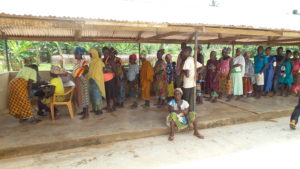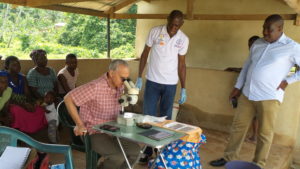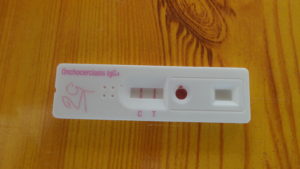Supportive Supervision during Ghana’s 2017 Onchocerciasis Survey
November 1st, 2017

Participants register for an onchocerciasis survey in Twifo-Adi-Mokwa district, Central region, Ghana. Photo: FHI 360
In 2017, END in Africa Project Director Bolivar Pou visited Ghana with three goals in mind: (1) reviewing progress toward neglected tropical disease (NTD) control and elimination in Ghana with staff from the national NTD program and FHI 360 (FHI 360 is the implementing agency in Ghana for the END in Africa project); (2) identifying and finding solutions to national NTD program challenges; and (3) conducting a field visit to the Twifo-Adi-Mokwa district to observe an onchocerciasis survey.
The project director spent the first part of his visit conducting a thorough review of the activities that were implemented the year before and the team’s plans for the rest of the fiscal year. As they reviewed the national NTD program’s progress, the project director and the team in Accra, composed of national NTD program staff and FHI360 staff, also jointly devised solutions to ongoing challenges.

END in Africa Project Director Bolivar Pou views a skin snip test, looks for onchocerciasis. Photo: FHI 360
In Ghana, a country with 28 million inhabitants, the Ministry of Health (MOH) works through autonomous agencies such as the Ghana Health Service (GHS), which help regulate the health sector and oversee health service delivery in Ghana’s 10 health regions and 216 health districts.[1] The GHS is responsible for the national control and elimination of NTDs targeted through preventive chemotherapy (PCT), including lymphatic filariasis (LF), onchocerciasis, schistosomiasis, soil-transmitted helminthiasis (roundworm, whipworm and hookworm), and trachoma.
Beginning in 2006, the US Agency for International Development (USAID) began supporting the work of Ghana’s national NTD program toward the control and elimination of the 5 aforementioned PCT NTDs. This support has been channelled through the END in Africa project, which has worked to support Ghana’s national NTD program since 2010. During this time, significant achievements have been made toward trachoma and LF control and elimination, but the nationwide onchocerciasis situation has remained unclear.
Onchocerciasis is a skin and eye disease caused by a filarial parasite (Onchocerca volvulus) and is transmitted by a small black fly called Simulium that breeds in fast-flowing well-oxygenated streams and rivers. Ghana has six major rivers with several tributaries, some of which are fast flowing and thus create the right conditions for Simulium breeding and transmission of onchocerciasis, also known as ‘river blindness.’ The vast majority of infections (99%) occur in sub-Saharan Africa, although cases have also been reported in Yemen and isolated areas of Central and South America. In Ghana, people who live close to rivers, in particular, are at risk for onchocerciasis.
The onchocerciasis program in Ghana started in 1974 with a vector control strategy; in 1998, the country began mass treatment of at-risk populations with preventative medicine, also known as mass drug administration (MDA). Following several surveys to determine where to treat the disease (mapping), 85 out of 216 districts were identified treatment, and between 2009 and 2016, all 85 districts were treated for onchocerciasis at least once a year.
Following the 2106 release of the WHO Guidelines for Stopping MDA and Verifying Elimination of Human Onchocerciasis, the END in Africa project supported Ghana’s national NTD program in conducting a nationwide impact assessment to determine the current onchocerciasis situation as a step toward achieving the country’s goal of disease elimination by 2025. In April–May 2017, the program conducted an epidemiological survey at 304 sites (communities) in 154 districts using the OV16 rapid diagnostic test (RDT), OV16 ELISA, and skin snip microscopy test. The OV16 RDT was conducted in children 5–9 years of age and skin snip microscopy was conducted in adults 20 years and over. All the children who tested positive for onchocerciasis using the OV16 RDT and a random selection of 10% of the children who tested negative were further tested using OV16 ELISA. After reviewing the preliminary survey results, the Ghana Onchocerciasis Elimination Committee (GOEC) recommended in June 2017, that 41 additional districts be treated through MDA, increasing the number of districts endemic for onchocerciasis in Ghana from 85 to 126.
On his 2017 supervisory visit to Ghana, the END in Africa project director spent a day observing an epidemiological assessment for onchocerciasis in a village in the Twifo-Adi-Mokwa district, Central region of Ghana. The survey team examined 120 people via either OV16 RDT (for children under 10 years of age) or the skin snip methodology (for adults 20 years and over). This visit enabled the project director to witness the conduct of a trachoma survey firsthand and to both interact with community members and motivate the survey team, thus helping to enhance overall commitment to the program and the control of onchocerciasis and other PCT NTDs in the community.
[1] Other autonomous agencies operating under the Ministry of Health include the National Health Insurance Authority, Health Training Institutions, and various regulatory bodies such as the Food and Drug Authority (FDA).



